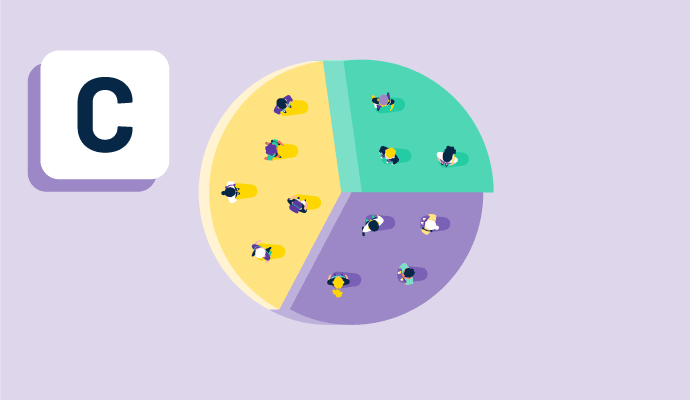What are customer segments?
Customer segments are individual groups of a company’s customer base that share common characteristics. Companies divide their customers into segments to market directly to each group.
Segmenting customers improves how a company communicates with its customers. Creating these segments helps it personalize customer journey, reaching customers with the right marketing messages to drive sales at the right time.
Customer segmentation reveals a company’s most kind of customer, allowing it to target the customers most likely to purchase. Companies can boost revenue, save time, and improve customer loyalty with customer segments. Often, organizations turn to CRM (customer relationship management) software for data surrounding the ins and outs of their customer base.
Customer segments types
Each type of customer segment groups customers using different criteria. The type a company chooses depends on the industry, customers, and products.
- Post hoc customer segments: This is the most popular segment type grouped based on shared characteristics or demographics. This information is collected from customer surveys, data, or other relevant sources.
- Needs-based customer segments: Grouped based on a specified demand for a product or service. It's used to provide a more realistic and accurate prediction of customer buying behaviour.
- Value-based customer segments: Grouped based on the value they bring to a company. It evaluates these customers based on specifics like the revenue they generate for a company, in addition to how much it costs the organization to maintain a relationship with them.
Basic elements of customer segments
The factors used to define customer segments depend on a company’s preferred marketing.
For B2B marketing, they're created according to:
- Industry
- Company size
- Previous purchases
- Location
For B2C marketing, they're defined based on:
- Age
- Gender
- Marital status
- Location
- Life stage
- Interests
- Needs
Customer segments benefits
Creating customer segments helps companies tailor marketing efforts to audience subsets. Doing so can go beyond tailoring customer communications and informing product development. The main benefits of creating customer segments are as follows:
- Targeted messaging: Allow marketers to target each customer segment directly, creating messaging that resonates more powerfully with their interests and needs than generic messaging.
- Prioritizing channels: Each segment has its communication channel of choice. When a company divides its customer base into segments, marketing teams can prioritize the most effective marketing channel for each segment rather than relying on a single channel.
- Better customer relationships: Helps marketers know their customers better. When customer service representatives know which customer segment they’re speaking to, they can provide a tailored customer service experience. Marketers with a solid understanding of the customers’ wants and needs are also better equipped to upsell or cross-sell relevant products and services. Customers appreciate being understood and respond with increased engagement and customer loyalty.
- Test safely: Companies can use these segments to test new pricing and products with a small segment of customers.
Customer segments best practices
Defining customer segments varies from company to company. Every customer base is different, but the following best practices apply in most cases:
- Don’t make the segments too small. Companies create segments to market directly to consumers, saving time in the process. When the groupings are too small, marketing teams can’t keep up or reap the expected benefits.
- Update as the customer base changes. Customer bases comprise living, breathing people and constantly change. For segments to remain beneficial, marketers need to consistently review data and redefine their marketing accordingly.
- Consider buying power. Customer segments without buying power or legitimate need for the product are useless for companies. Metrics like market share, share of preference, and lifetime value help identify the most valuable segments.
Customer segments vs. market segments
Customer segments and market segments come from different segmentation techniques. Despite the differences, some marketers use them synonymously.
Market segments divide a company’s target market into smaller segments with similar characteristics, interests, and location. They aren't as detailed, as they provide a broad overview of a company’s customers, market, and place in the market.
Customer segments groups customers based on metrics like expectations or demographics. These segments help companies create detailed buyer personas. They’re typically larger and boost revenue and customer retention.

Martha Kendall Custard
Martha Kendall Custard is a former freelance writer for G2. She creates specialized, industry specific content for SaaS and software companies. When she isn't freelance writing for various organizations, she is working on her middle grade WIP or playing with her two kitties, Verbena and Baby Cat.

